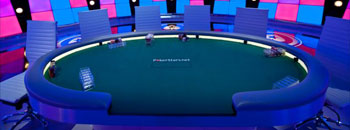Fighting Jet Lag in London, on to Day Three

Poker Blog
- Why I’ve Accepted the Challenge
- The WSOP POY Oopsie!
- Should We Care if People in the US use a VPN?
- A Common Sense Rewards System
- My Perfect Poker Tournament
- The State of Poker 2019
- My Summer Schedule
- Top 5 Reasons the Vegas Golden Knights are Winning
- The Conclusion of the $100k Super High Roller at PCA
- Day 1 $100k PCA Super High Roller
I had a very blaze day in terms of chip movement, coming in with 89,000, topping out at 127,000 and ending at 113,100 which is where I was for most of the four levels. I never dipped below 90,000 and avoided major confrontations as best I could and am very happy with that decision.
I changed clothes like three times! Every break I went to buy something new. I was on one of the feature tables again, which means no massages and very hot, bright lights. I came in wearing a blue argyle sweater and ended up in a dark blue Oxford T-shirt and a funky hat.
You can’t wear any logos on your hat, so my PokerStars.net hat was a no go. Today I’ll be more prepared with just a t-shirt and hat. The only reason I need the hat is the lights. I went through the same thing last year and did fine, so I know I can deal with it, it just requires a few adjustments.
I couldn’t believe it when I woke up this morning and found my table draw. I sit in 38th place in chips, yet incredibly, I am the chip leader at my table! You just don’t see that very often with less than 100 players remaining:
1. Daniel Negreanu 113,100
2. Jani Vilmunen 65,500
3. Kim Wooka 22,000
4. Men Nguyen 27,500
5. Arnauld Mattern 86,600
6. Jean Montury 25,800
7. Leo Margets 48,300
8. Elijah Berg 91,900
9. Michael Wang 60,700
I know of three of these players. Men Nguyen, obviously, Jani Vilmunen who I played with yesterday and know through Patrik, and finally, Leo Margets “The last woman standing” who I became a fan of after watching some of her interviews online. She really impressed me with the way she carried herself in interviews, not a hint of bravado or arrogance and a really good command of the English language despite it not being her first language.
I’m a bit of a poker geek and watch a lot of the video interviews online and she’s the best newcomer I’ve seen in years. Energetic, intelligent, and humble.
The table composition, despite me being the chip leader, isn’t ideal for me. There are too many short stacks at the table to allow me to play a large volume of hands profitably since short stacks are more likely to re-raise you than an average stack is.
For example, when I’m in the cutoff seat, the two blinds, Men Nguyen and Wooka Kim both have under 30,000. The blinds will be 800-1600 so my standard raise will be to 3800. Those are ugly situations to be in if you are raising with marginal hands. You get priced into a lot of calls in that spot, but I approach these situations much differently than most online players. Online players lean towards calling in these spots a lot more than I do, and while that might be the right approach in faster paced tournaments, in these deep stacked events I think they are making a mistake, but that’s another blog entirely. If the math is at all close, folding is usually the better option provided that you are one of the better players at the table.
The concept is similar to why you don’t race pre-flop in coin flip situations. Let’s say you KNOW your opponent had AK and you have 55. It costs you 18,000 to win 19,200. On paper, your 55 are a favorite, AND you are getting a price on the call. Calling can’t exactly be “incorrect,” but I’d argue that it’s often not the optimal play, because the value of winning the pot doesn’t compensate for what you may give up by losing the flip in terms of opportunity.
So, if you are getting 2-1 odds on a call, and you feel that your opponent will average out to be a 2-1 favorite against your hand- it’s a fold. It’s an even money bet, and that’s not good enough! In a tournament, there is no need to make even money bets on the flip of a coin. If you are a winning player, you should be looking for spots where you have significant value.
Anyway, time for breakfast, a shower, then heading over to the Empire casino.
]]>


